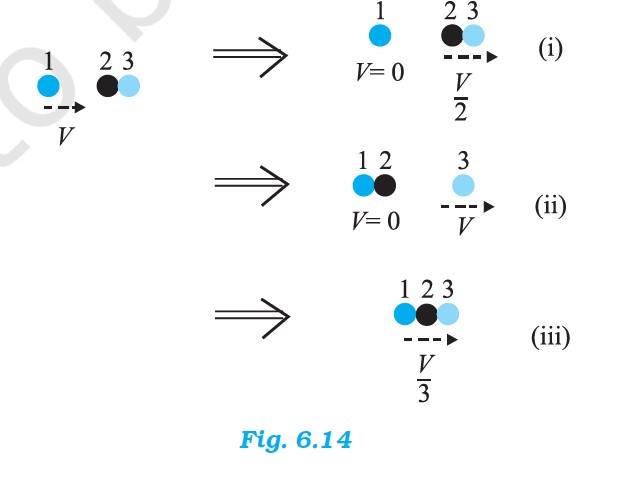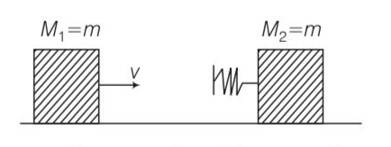6.16 Two identical ball bearings in contact with each other and resting on a frictionless table are hit head-on by another ball bearing of the same mass moving initially with a speed V. If the collision is elastic, which of the following (Fig. 6.14) is a possible result after collision ?

6.16 Two identical ball bearings in contact with each other and resting on a frictionless table are hit head-on by another ball bearing of the same mass moving initially with a speed V. If the collision is elastic, which of the following (Fig. 6.14) is a possible result after collision ?

-
1 Answer
-
6.16 The mass of the ball bearing = m
Before the collision, the total K.E. of the system = K.E. of the stationary ball bearing + K.E. of the striking ball bearing = 0 +
After the collision, the K.E. of the total system is
(a) Case (i) = 0 + =
(b) Case (ii) = 0 +
(c) Case (iii) = =
Case (ii) is possible since K.E. is conserved in this case.
Similar Questions for you
Using Newton’s formula,
This is a multiple choice answer as classified in NCERT Exemplar

This is a multiple choice answer as classified in NCERT Exemplar
(b) conserving energy between “O” ans ”A”

Ui + Ki = Uf + Kf
0+1/2mv2= mgh + 1/2mv’
(v’)2=v2-2gh = v’= ……….1
Let speed after emerging be v1 then
=1/2mv12=1/2[1/2mv’2]
1/2m(v1)2=1/4m(v’)2=1/4m[v2-2gh]
V1= ………….2
From eqn 1 and 2
So v1 = v’/ =v2(v’/2)
v1>v’/2
hence after emerging from the target velocity of the bullet is more than half of its earlier velocity v’
(d) as the velocity of the bullet changes to v’ which is less than v’ hence , path
This is a multiple choice answer as classified in NCERT Exemplar
(b, d) When a man of mass m climbs up the staircases of height L, work done by the gravitational force on the man is mgl work done by internal muscular forces will be mgL as the change in kinetic is almost zero.
Hence total work done =-mgL + mgL=0
As the point of application of the contact forces does not move hence work done by reaction forces will be zero.
This is a multiple choice answer as classified in NCERT Exemplar
(c) m =150g =3/20kg
Time of contact =0.001s
U=126km/h=
V= -35m/s
Change in momentum of the ball = m (v-u)=
=21/2
F= dp/dt=- = - 1.05
Here – negative sign indicates that force will be opposite to the direction of movement of the ball before hitting.
Taking an Exam? Selecting a College?
Get authentic answers from experts, students and alumni that you won't find anywhere else
Sign Up on ShikshaOn Shiksha, get access to
- 65k Colleges
- 1.2k Exams
- 679k Reviews
- 1800k Answers

